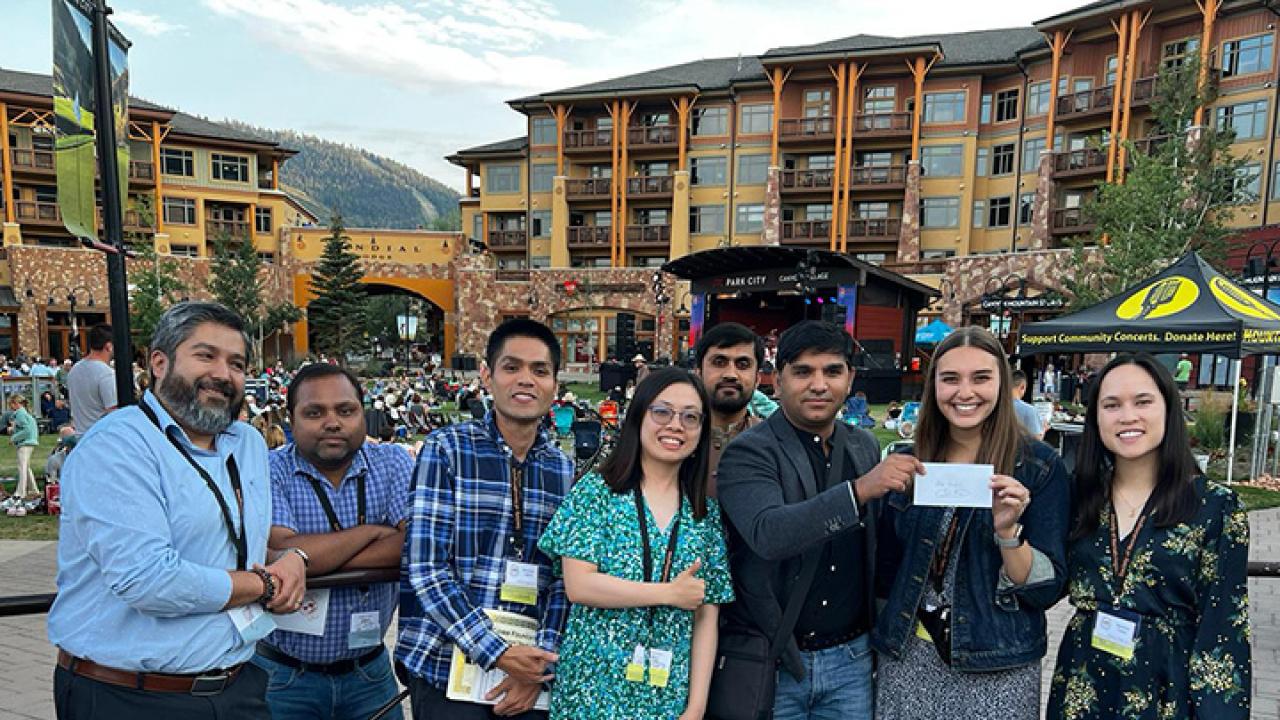
UC Davis Nematology Doctoral Students Do Well at International Conference
Alison Blundell Wins Second in Student Competition

Nematology graduate students in the laboratory of associate professor Shahid Siddique, Department of Entomology and Nematology did well at the 63rd annual meeting of the Society of Nematologists (SON), held recently in Park City, Utah.
Doctoral candidate Alison Blundell won second place in a 12-minute student oral competition with her invited presentation, “Overcoming Resistance: Unraveling the Mechanisms Behind Root-Knot Nematode Evasion of Tomato Mi-Gene.” She received a $250 prize.

Blundell, who anticipates receiving her doctorate in 2026, researches plant-parasitic nematodes specifically root-knot nematodes, and their molecular mechanism to defend against plant immune systems. In her abstract, she wrote: "Root-knot nematodes (RKNs) are among the most devastating pathogens of crops, causing substantial yield and economic losses worldwide. These parasitic organisms can infect over a hundred different plant species and can evade plant defense mechanisms by secreting a concoction of effectors. For decades, the Mi-1 resistance gene has been effective in detecting and inhibiting RKNs in tomatoes. However, the underlying mechanisms by which Mi-1 detects these pathogens remain largely unknown. In recent years, resistance-breaking populations have emerged in both greenhouse and field settings, posing a threat to the potency and effectiveness of the Mi-1 gene and, consequently, the tomato industry. "
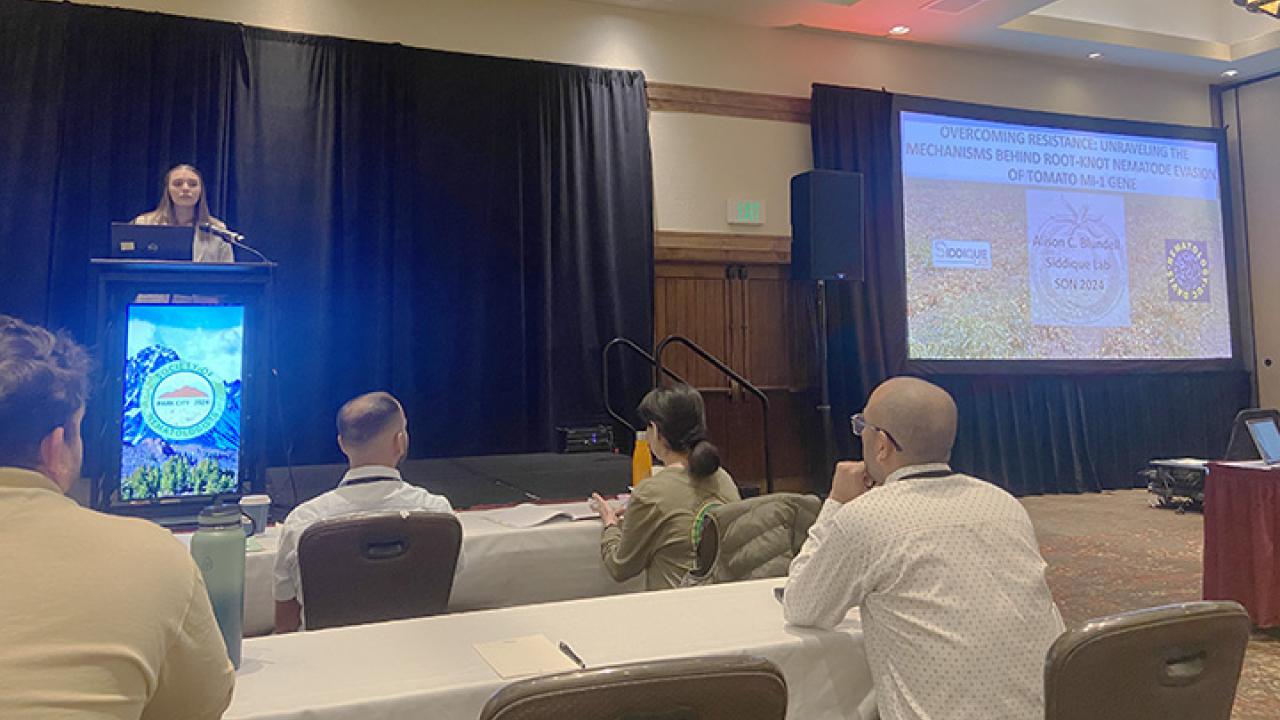
"We used two strains of M. javanica, one strain VW4, which is recognized by Mi-1, and another strain, VW5, which was selected from VW4 and can overcome resistance mediated by Mi-1," Blundell explained. "Utilizing the newly constructed reference genome for M. javanica (VW4), we compared genomes of VW4 and VW5 and identified an approximately 50 kb region that is present in VW4 but missing in VW5. This missing region contains seven protein-coding genes, three of which encode putative effectors and are currently being tested as potential avirulence genes for Mi-1."
"In addition, we have conducted a series of infection assays on different host plants lacking Mi-1, and the results revealed a significantly lower egg count in VW5 when compared to VW4. We plan to expand these assays by testing additional M. javanica resistance-breaking strains collected from fields all over California to determine if this trade-off is consistent across other strains. Overall, our results suggest that although VW5 can overcome Mi-1, there is a trade-off in the form of compromised reproduction. This research helps to better understand the mechanism and components of Mi-1 and develop strategies for addressing resistance-breaking populations."
Postdoctoral fellow Dave Ste-Croix of the Saint-Jean-sur-Richelieu research and development Centre, Saint-Jean-sur-Richelieu, Québec, won the 12-minute student competition with his presentation, "Exploring MiRNA Dynamics in the Soybean Cyst Nematode as a First-Step Towards Unraveling Potential Cross-Kingdom Interactions."
Blundell and Siddique also delivered invited presentations in the illustration workshop. Blundell gave her presentation on "Become an Illustrator Mender Simply by Using BioRender," and Siddique, "Doodle Your Data: Adobe Illustrator for Nematodes."
Doctoral student Veronica Casey of the Siddique lab delivered an invited presentation on “Pathogenic Hitchhikers: Investigating the Synergy of Bacteria and Nematodes on Plant Health.”
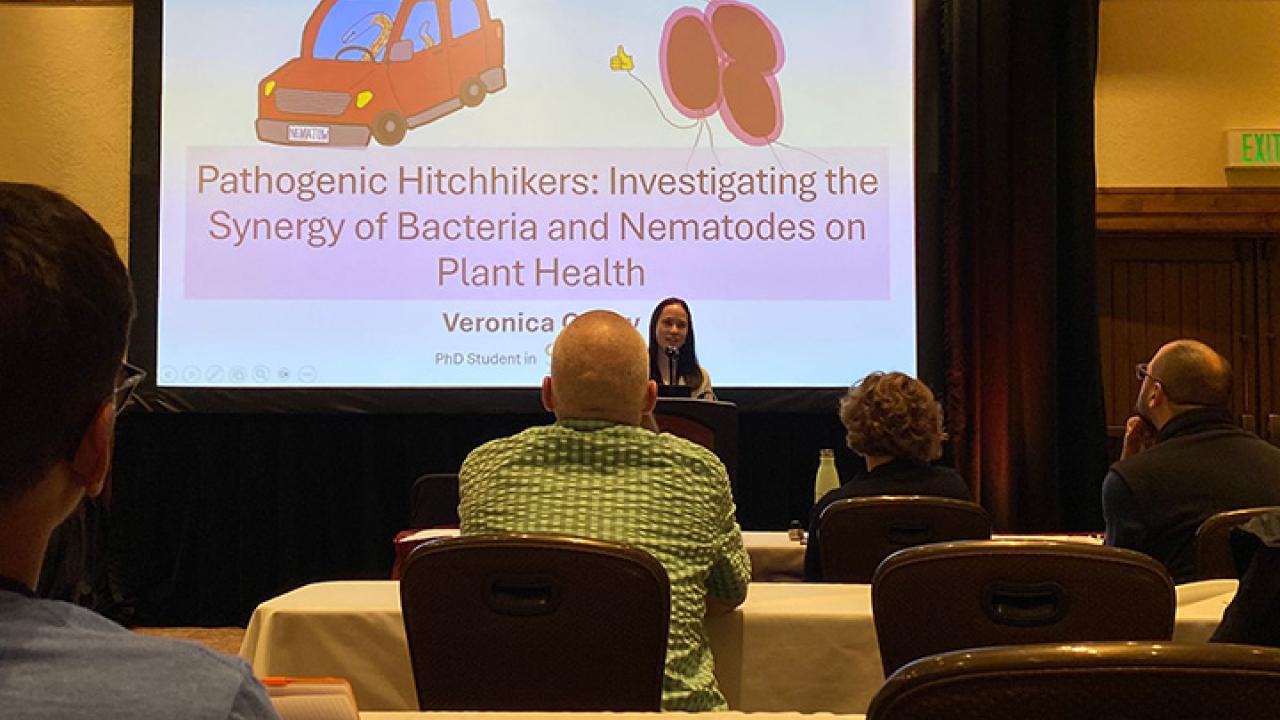
"In the vast scope of soil ecology, plant-parasitic nematodes can forge alliances with other microbial adversaries, such as the disease complex formed between nematodes and bacterial wilt-causing Ralstonia spp.," Casey wrote in her abstract. "These disease complexes exacerbate disease symptoms and yield losses. Plant-parasitic nematodes are microscopic roundworms that cause approximately $100 billion in yield loss a year, and most of the damage is attributed to root-knot nematodes (RKNs; Meloidogyne spp.). Bacterial wilt is caused by multiple Ralstonia species, namely Ralstonia pseudosolanacearum, R. solanacearum, and R. sygzii that enter the plant’s roots to colonize its vascular system. Prior to Ralstonia infection, RKN infection may facilitate bacterial disease by increasing access to the vascular tissue."
"However, little research has been conducted to elucidate the molecular details of this interaction," Casey pointed out. "Previous reports of RKN and Ralstonia spp. in the field hypothesized that the infection was due to root wounding and physiological changes. In this study, I will determine the nature of the interaction between Ralstonia and nematodes at both ecological and molecular levels. This research project will explore the hypotheses that 1) Ralstonia adheres to the cuticle of nematodes using specialized appendages called pili and 2) de novo xylem formation in the galls increases Ralstonia transport into the plant. A common strategy for preventing nematode infection is by using resistant plant cultivars."
"However, resistance-breaking nematode populations have arisen and we plan to utilize resistance-breaking nematodes, which are most likely to interact with bacterial wilt in the field," Casey noted. "This presentation will report on the attachment and greenhouse experimental results of the RKN-Ralstonia complex. The escalation of climate change is leading to increased instances of pathogenicity; therefore, it is crucial to uncover disease complexes which can have monumental consequences on food security. A meticulous study into the nematode and Ralstonia disease complex will support the management of these damaging pathogens across the world."

Several other Siddique lab members participated in the international conference. Postdoctoral fellow Bardo Castro and Tushar Dutta, a guest scientist from India, delivered a presentation on their work on genome editing in tomato and rice crops. Four lab members, Ching-Jung Lin, Dadong Dai, Romnick Latina, and Syed Shamsullah, each contributed a poster presentation.
Chris Pagan, doctoral candidate in the laboratory of UC Davis distinguished professor Steve Nadler, presented a talk in the Ecology Session on “Nematode Community Structure in the Rhizopsheres of Southern California Creosote (Larrea trientata).” In his abstract, Pagan wrote: "Creosote bush (Larrea tridentata) is widely distributed across the arid regions of the southwestern United States. These resilient shrubs restructure and enrich the soil beneath them, creating islands of fertility that support relatively dense and diverse nematode communities. We employed a metabarcoding approach to survey nematode diversity and abundance in the rhizospheres of creosote bushes across 11 desert habitats in Southern California. Nematodes were extracted from 64 soil samples using Baermann funnels, and pooled nematodes from each sample were PCR-amplified with 5’ 28S barcoding primers. The amplified products were sequenced on the PacBio Sequel II platform."
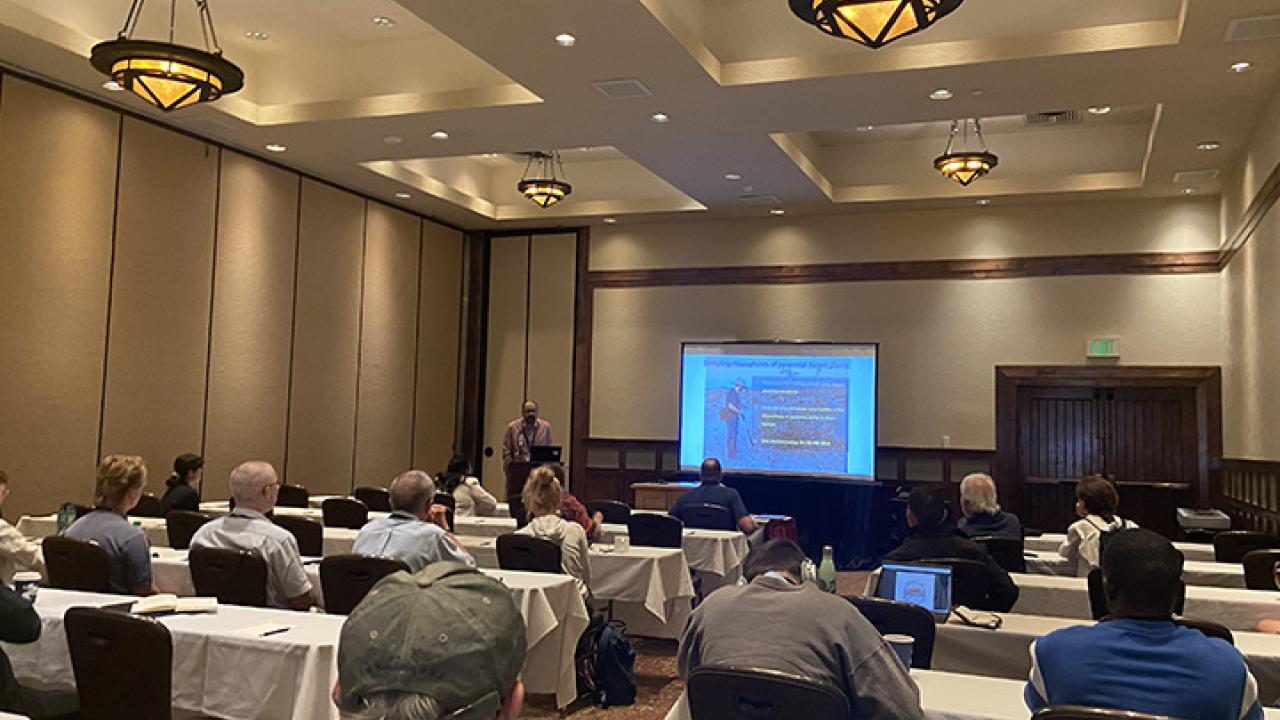
"The resulting sequence data were denoised using the dada2 plugin within the Qiime2 bioinformatic pipeline," Pagan related. "Using the sklearn naïve Bayes classifier and a custom 28S reference sequence database, we identified 2319 amplified sequence variants (ASVs) and assigned 92 taxonomic classifications across all samples. There were 62 species-level classifications, although ASVs from some groups, such as Panagrolaimomorpha, are likely overclassified due to underrepresentation in our custom reference sequence database. Patterns in the geographic distribution of ASVs and site-specific drops in the confidence values associated with their classification suggest the presence of additional species or distinct populations. Additionally, we measured 14 soil physicochemical properties to determine whether nematode community composition correlates more strongly with specific abiotic and environmental factors or with geographic location. Preliminary results suggest that geographic location is a weak predictor of community composition, while factors that affect soil texture and water retention are more significant."
Four graduate students from the Siddique lab received travel awards: Ching-Jung Lin, a Bayer CropScience award; Romnick Latina, a N. A. Cobb Foundation award; Alison Blundell, a Corteva award; and Veronica Casey, a Certis award.
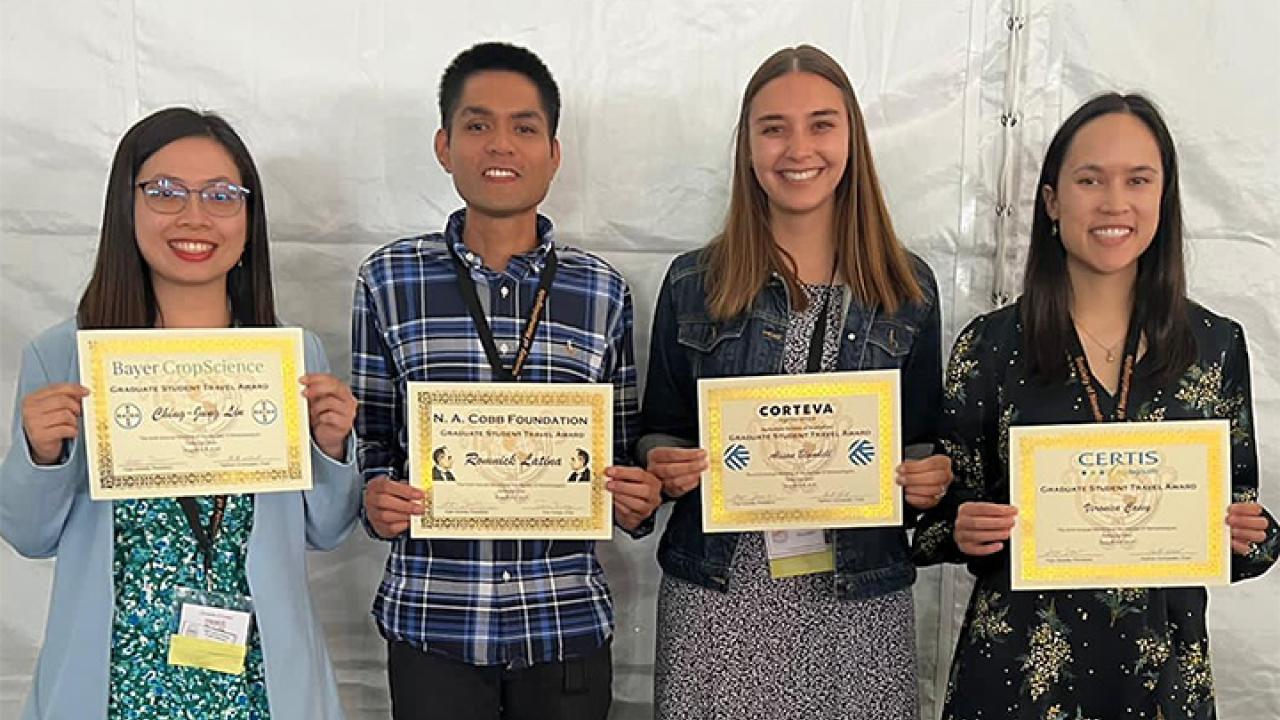
The Society of Nematologists is an international organization that advances the science of nematology in both its fundamental and economic aspects. The 2025 conference will take place July 13-17 in Victoria, British Columbia, Canada.
(Editor's Note: Howard Ferris, former chair of the UC Davis Department of Nematology (now the Department of Entomology and Nematology) received SON's highest award, Honorary Member. He will be featured in a forthcoming life story.)
